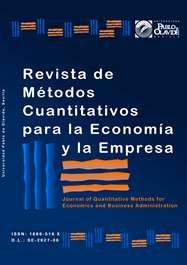Aplicación de la hipótesis de paridad de poder adquisitivo en el pronóstico de la tasa de cambio del peso colombiano contra el dólar estadounidense
DOI:
https://doi.org/10.46661/revmetodoscuanteconempresa.4476Palabras clave:
pronóstico, peso colombiano, petróleo WTI, Modelos VEC, paridadResumen
Este paper muestra el pronóstico de la tasa de cambio entre el peso colombiano y el dólar estadounidense (en adelante dólar) desde Diciembre del 2019 hasta Diciembre del 2020, basado en un modelo VEC (Vector Error Correction) a partir de la hipótesis de paridad de poder adquisitivo débil. Con esto, se propone que la tasa de cambio se ajusta no solamente para equilibrar las diferencias en precios entre Estados Unidos y Colombia, sino también para equilibrar una tercera variable, en este caso el precio del petróleo WTI. Dado que la principal fuente de ingresos por exportaciones para Colombia son los recursos petroleros, se consideró valioso usar las cotizaciones del WTI como proxy para estimar la probable dirección que siga la tasa de cambio en el corto y medio plazo.
Descargas
Citas
Akaike, H. (1974). A new look at the statistical model identification. IEEE Transactions on Automatic Control, 19(6), 716-723. https://doi.org/10.1109/TAC.1974.1100705
Amuzegar, J. (1978). OPEC and the Dollar Dilemma. Foreign Affairs, 56(4), 740-750.
Banco de la República de Colombia (2019, Diciembre 13). banrep.gov.co. Retrieved from https://www.banrep.gov.co/es/estadisticas/trm
Cerquera, O.H., Gómez, C.F., & Arias, C. J. (2018). Purchasing power parity in the Colombian exchange rate. Ánfora, 25(45), 123-143. https://doi.org/10.30854/anf.v25.n45.2018.515.
Cochrane, S., & DeFina, R. (1995). Predictable components in exchange rates. Quarterly Review of Economics and Finance, 35(1), 1-14.
Cumby, R., & Obstfeld, M. (1984). International interest rate and price level linkage under flexible exchange rates: review of recent evidence. In R. M. Bilson, Exchange Rate Theory and Practice (pp. 121-151). Chicago, Estados Unidos: University of Chicago Press.
DANE (2019, agosto). DANE. Retrieved from https://www.dane.gov.co/index.php/estadisticas-por-tema/comercio-internacional/exportaciones
Engle, R.F., & Granger, C. (1987). Co-integration and error correction: representation, estimation, and testing. Econometrica, 55(2), 251-267.
Federal Reserve Bank of St Louis (2019). fred.stlouisfed.org. Retrieved from https://fred.stlouisfed.org/series/TWEXB
Frenkel, J.A. (1981). Flexible Exchange Rates, Prices, and the Role of News: Lessons from the 1970s. Journal of Political Economy, 89(4), 665-705.
Garín, J., Lester, R., & Sims, E. (2018). Intermediate Macroeconomics. Indiana: University of Notre Dame.
Granger, C.W. (1969). Investigating Causal Relations by Econometric Models and Cross-spectral Methods. Econometrica, 424-438.
Gregorio, J.D. (2012). POLICY CORNER: Commodity Prices, Monetary Policy, and Inflation. IMF Economic Review, 60, 600-633. https://doi.org/10.1057/imfer.2012.15
Hernández, C.F., Mesa, R.F., & Pareja, I.V. (2009). Proyección de la tasa de cambio de Colombia bajo condiciones de PPA: evidencia empírica usando var. Estudios Gerenciales, 25(113), 211-226.
Holmes, M., & Wang, P. (2005). Do African countries move asymmetrically towards Purchasing Power Parity? South African Journal of Economics, 73(2), 292-301. https://doi.org/10.1111/j.1813-6982.2005.00018.x
Jacobson, T., & Nessen, M. (2004). Examining world-wide Purchasing Power Parity. Empirical Economics, 29, 463-476. https://doi.org/10.1007/s00181-003-0176-2
Johansen, S. (1988). Statistical analysis of cointegration vectors. Journal of Economic Dynamics and Control, 231-254. https://doi.org/10.1016/0165-1889(88)90041-3
Johansen, S., & Juselius, K. (1990). Maximum likelihood estimation and inference on cointegration - with applications to the demand for money. Oxford Bulletin of Economics and Statistics, 52(2), 169-210. https://doi.org/10.1111/j.1468-0084.1990.mp52002003.x
Kim, Y. (1990). Purchasing power parity: another look at the long-run data. Economics Letters, 32(4), 339-344. DOI: https://doi.org/10.1016/0165-1765(90)90026-W
Krugman, P. (1978). Purchasing power parity and exchange rates. Journal of International Economics, 8(3), 397-407. DOI: https://doi.org/10.1016/0022-1996(78)90003-X
Kugler, P., & Lenz, C. (1993). Multivariate Cointegration Analysis and the Long-Run Validity of PPP. The Review of Economics and Statistics, 75(1), 180-184. https://doi.org/10.2307/2109645
Lipschitz, L., & Schadler, S. (2019). Macroeconomics for Professionals: A guide for analysts and those who need to understand them. Cambridge, United Kingdom: Cambridge University Press.
Macdonald, R. (1993). The monetary approach to the exchange rate: rational expectations, long-run equilibrium, and forecasting. IMF Staff Papers, 92(34), 89-107.
Mankiw, N.G. (2016). Macroeconomics. Nueva York: Worth Publishers, Macmillan.
Papell, D., & Podran, R. (2006). Additional Evidence of Long-Run Purchasing Power Parity with Restricted Structural Change. Journal of Money, Credit, and Banking, 38(5), 1329-1349. https://doi.org/10.1353/mcb.2006.0073.
Patel, J. (1990). Purchasing power parity as a long run relation. Journal of Applied Econometrics, 5(4), 367-379. https://doi.org/10.1002/jae.3950050405.
Serletis, A., & Gogas, P. (2004). Long-horizon regression tests of the theory of purchasing power parity. Journal of Banking & Finance, 28(8), 1961-1985. https://doi.org/10.1016/j.jbankfin.2003.07.006.
Taylor, M. (1988). An empirical examination of long-run purchasing power parity using cointegration techniques. Applied Economics, 20(10), 1369-1381. https://doi.org/10.1080/00036848800000107.
Urrutia, M., & Llano, J. (2012). Los actores en la crisis económica de fin de siglo. Bogotá: Ediciones Uniandes.
Varian, H. (1992). Microeconomic analysis. New York: W.W. Norton & Company, Inc.
Wang, P. (2009). The Economics of Foreign Exchange and Global Finance. Berlín, Alemania: Springer.
Publicado
Cómo citar
Número
Sección
Licencia

Esta obra está bajo una licencia internacional Creative Commons Atribución-CompartirIgual 4.0.
El envío de un manuscrito a la Revista supone que el trabajo no ha sido publicado anteriormente (excepto en la forma de un abstract o como parte de una tesis), que no está bajo consideración para su publicación en ninguna otra revista o editorial y que, en caso de aceptación, los autores están conforme con la transferencia automática del copyright a la Revista para su publicación y difusión. Los autores retendrán los derechos de autor para usar y compartir su artículo con un uso personal, institucional o con fines docentes; igualmente retiene los derechos de patente, de marca registrada (en caso de que sean aplicables) o derechos morales de autor (incluyendo los datos de investigación).
Los artículos publicados en la Revista están sujetos a la licencia Creative Commons CC-BY-SA de tipo Reconocimiento-CompartirIgual. Se permite el uso comercial de la obra, reconociendo su autoría, y de las posibles obras derivadas, la distribución de las cuales se debe hacer con una licencia igual a la que regula la obra original.
Hasta el volumen 21 se ha estado empleando la versión de licencia CC-BY-SA 3.0 ES y se ha comenzado a usar la versión CC-BY-SA 4.0 desde el volumen 22.










